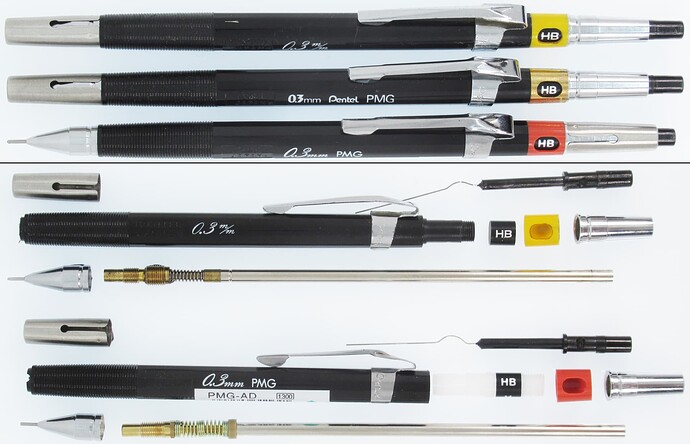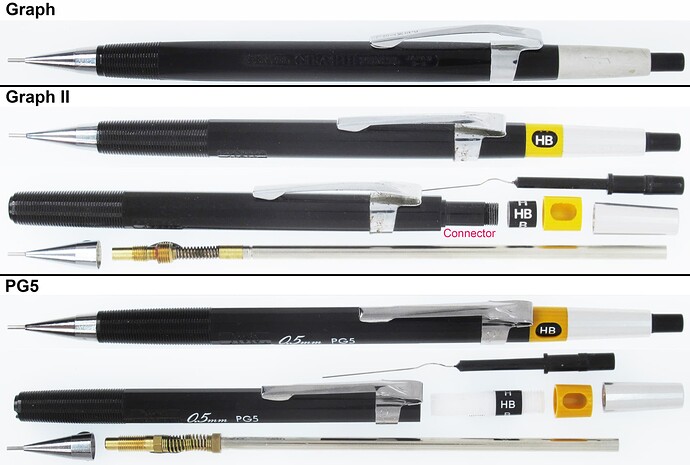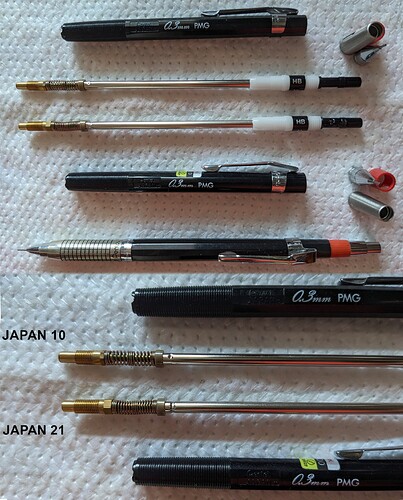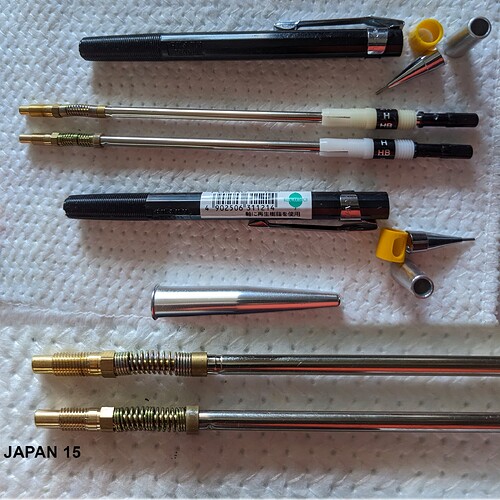I am working on a new version of the Pentel ID Book, and I have a few questions I will be posting on here.
Back in 1969-70, when Pentel decided to release lower cost versions of the Mechanicas, they released the PMG and the Graph II.
The initial PMG and Graph II are designed very differently than later versions of the PMG and PG5.
My question is, should I break out the PMG into two different Versions (see Pentel ID Book Question 1 - Generation, Version &? for definition), like the Graph II and PG5 (yes, I know they are different models), or leave them as 1 listing, as I have it now in the Pentel ID Book (v2022.11)? I am leaning towards splitting them up, but I am asking for input on this, as I want this book to be more collaborative, rather than just my voice.
3 Likes
If you’re going to split them up—which I think is ultimately helpful and the right way to do it—you’d need to detail every single difference between the generations. Otherwise, I wouldn’t see much point in breaking them up.
I have two PMG’s. One that I bought about 6+ years ago, and one I bought just recently. They’re showing the 3rd generation labeling. However, there are some minor differences. Next to “JAPAN” there is a 2 digit number. The one I bought earlier has “10” and the later one I bought has “21”.
Clip “Pentel” imprint font: On the 10, it is thinner and slightly larger, while on the 21 it’s thicker and slightly smaller.
Body embossed lettering: On the 10, “JAPAN” is more narrow, while on the 21, “JAPAN” is spaced out more. The “Pentel” logo appears just a little thicker on the 21.
Nose cone diameter: The 21 is slightly more narrow than the 10.
Rear chromed steel collar: The 21 has a slightly more shallow groove. The 10 makes a notable feeling “click” when docking the protective collar, while the 21 is much more subtle.
Mechanism screw threads: The 21 has a longer section of screw threads than the 10.
Mechanism shaft: The 21 has “3F” lightly stamped into it, while the 10 has no marking.
EDIT: I did figure out how to extract the mechanism fully. The plastic screw-thread connector was just really stuck in place. I was able to rotate it after applying careful, progressive torque force. The brass housing for the chuck and the springs look very much the same.
2 Likes
In terms of production optimization going forward, you would think that in cases where screw thread segments change, the company would opt for fewer threading as a cost cutting measure.
I have an older PG5 which simply has embossed “Pentel PENCIL” where the newer PG5 bought just recently has “Pentel JAPAN” and there’s a 2 digit batch code (mine has 15). Looking closely at the brass housing for the chuck, the screw threads are longer on the older PG5. That would suggest a reduction with later production to save costs.
Conversely, with the PMG copies I have, the older batch actually has fewer screw threads versus the later batch. Kind of surprising. One explanation I’ve heard concerning other writing instrument production batch changes is that sometimes parts are outsourced from different vendors that may make specification changes for various reasons. Given the nature of mechanical pencil stresses, I really don’t see how retooling for changes in the number of screw threads in this minor degree presents any tangible benefit. I suspect it wasn’t a deliberate choice, but instead just an incidental change due to 3rd party sources.
PHOTOS:
PMG
PG5
2 Likes



